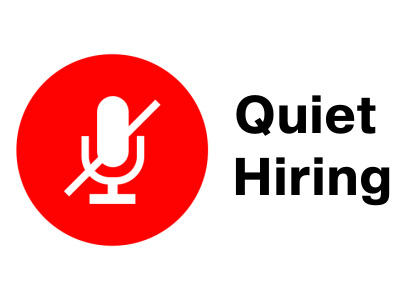Soon after “quiet quitting” made headlines, another term emerged in HR circles: “quiet hiring.” The phrase may be new, but the concept isn’t.
Quiet hiring is the practice of developing employees and moving them to a new role or focus area to help businesses adapt to changing needs. It allows people to learn skills, follow new passions, or be reassigned from one team to another to meet the evolving needs of a quickly growing business.
Some examples of quiet hiring are training factory workers on new equipment before a product launch or redeploying tax specialists to other projects after tax season.
It’s not about giving more work to fewer people, but a way for employees to temporarily explore a different career without leaving their employer. And it can be an effective tool in preventing employee burnout and disengagement.
Why Quiet Hiring Is Important
Economic conditions and business needs can change quickly. Quiet hiring gives businesses more flexibility while expanding the skill set of its employees. When done well, it benefits people and the organization.
In practice, quiet hiring may look like:
- reassigning an administrative assistant to focus on a major contract for six months
- upskilling employees to work with new software
- moving manufacturing staff to a product with increased consumer demand
- encouraging employees to learn about a new area of specialty through mentorship or training
In these scenarios, the result is that businesses become more agile and better able to adapt to change or quick growth. In a recession, quiet hiring further allows a company to retain staff by moving people into other areas rather than reducing head count.
It’s common for organizations to use quiet hiring to meet short-term needs or changing priorities, but it can be beneficial at any time.
People-first organizations should use quiet hiring to retrain and upskill staff as needs arise.
Best Practices for Quiet Hiring
Your organization may already quiet hire to some degree. Consider these four recommendations before embracing the practice on a wider scale.
1. Get buy-in from leadership. Leaders should allow employees to work in other departments occasionally so that when quiet hiring is needed, the organization can act quickly. This could be someone in accounts payable assisting accounts receivable from time to time. Or it could be more formal, such as cross-training team members to perform critical functions when staff members are out.
2. Create an internal mobility policy. Quiet hiring is more successful at businesses with policies that facilitate employee transfers between teams and cross-functional work. If your organization doesn’t have a mobility policy, consider implementing one.
3. Put people first. Quiet hiring works best when employees are on board with it. The first step is to gain insight into their interests through a survey or conversations. An office employee who enjoys working with the public will more readily embrace a seasonal retail position than a randomly selected worker.
Poor communication can result in employee frustration and confusion instead of enthusiasm. Communicate clearly to help employees understand why they’re being asked to make a temporary or permanent move.
Explain the goals driving the change and how it can be good for the employee’s career. The expertise they gain working in a different area can open new opportunities, both inside the company and for future jobs.
4. Look inside before hiring externally. When a need for new staff is identified, consider reassigning current employees whose typical areas of focus may not be a priority. This can save time and money since there’s no need to invest in recruitment, onboarding, and training of new hires.
The Role of HR Tech in Quiet Hiring
HR software can help businesses learn about employee interests and workloads, make sure workers are ready for a change of assignment, and facilitate smooth transitions. Here are four ways HR tech can make successful quiet hiring possible.
1. Survey employees. Sending a survey through HR software can help you learn which workers are interested in other duties.
2. Provide training. Once you’ve identified skills gaps, a robust learning and development tool helps upskill those employees for different tasks, setting them up for success.
3. Prevent payroll issues. Quiet hiring typically doesn’t require a change in compensation packages or salaries. When it does, it’s important for HR teams to ensure workers understand how their take-home pay will increase, then make the change happen seamlessly.
Having a payroll error accompany a job transition can hurt employees and your company. One in five payrolls have mistakes, and a typical payroll problem costs $291, according to new Ernst & Young nationwide research commissioned by Paycom. Those mistakes add up quickly, affecting your bottom line and causing employees to make hard decisions about their finances, like which bills to pay … and which to painfully put off.
4. Use the right technology. Make sure the HR tech you use is up to date and user-friendly. A OnePoll survey commissioned by Paycom found that nearly 80% of U.S. employees get frustrated by outdated technology at work. In fact, almost 70% said they would be willing to take a pay cut to have software that’s twice as good as what they have.
Although quiet hiring isn’t new, doing it well requires intentional planning and careful execution. Getting buy-in from all people affected and communicating throughout the process are key, and the right HR tech can facilitate smooth transitions. With each of these elements in place, quiet hiring can pay off for workers and employers.
Jennifer Kraszewski, Vice President of Human Resources at Paycom, has more than 25 years of HR leadership experience, driving transformative, business-focused human capital strategies in high-growth industries to achieve efficiencies, compliance and employee engagement. Under her leadership, she has helped secure Paycom’s spot on Glassdoor’s Best Places to Work list among large employers and recognition in HR.com’s Leadership Excellence and Development Awards for outstanding leadership development programs.
The post Quiet Hiring: What HR Pros Should Know appeared first on HR Daily Advisor.
